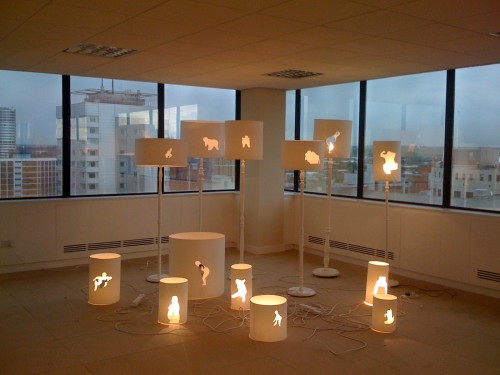
This won’t be accurate. I didn’t take notes; I didn’t record. It was meant to be a night out, only, in good company, on the 14th floor of West Riding House, one of the city’s largest office blocks whose entrance you ignore because your attention is drawn to Urban Outfitters on one side or Greggs on the other. But there it is, West Riding House, and somehow East Street Arts, for this event – “…and and from the west behold! A pale horse…” … had found this space, its contours that of a thousand offices staffed by bored workers, and made it lovely, spare and empty except for chairs, Emma Bolland’s pretty but pretty dark art – crime fiction books with their titles erased, their samey sinister copse covers suddenly ridiculous for their sameness; a family of lamps – and such a view over Leeds, to its hills of Hyde Park and the ugliness of Quarry House. So much city so close to greenery, and also to wasteland.
And that brings me to David Peace, though he grew up in Ossett, not a bad place, with posh bits, but he grew up in Yorkshire Ripper times, like I did and many of us did, and he uses the wasteland of Leeds and Wakefield and Ossett for the scenes in his Red Riding Quartet, because that is what the Ripper did. But back to the accuracy of this: that is somewhat the point, as this evening’s discussion is billed as being about crime and art, between David Peace, Leeds-based artist Emma Bolland and Jake Arnott, best-known for The Long Firm but also well-known in Leeds from his nine years here, but it was actually a discussion about authenticity and truth. There were readings but also conversation. The readings were from Peace, one of those rare writers who can read his own words well, in their concerted disconcertingness, in a voice that compels despite its deliberatedly limited tones. What was said? I was two glasses of wine in by then, so I must review from memory, but I know there was talk about the victims who have no voices, usually, in mainstream coverage. This isn’t surprising when the media of Yorkshire Ripper times virtually ignored the death of four women until Jayne McDonald, the first “innocent victim,” that is, not a sex worker and therefore a proper human being. There was talk about the medium, about the power of art and fiction to give victims the voice that they don’t get in life or death. There were far too many mentions of “tropes.”
And, because there was agreement, seemingly, that truth is more easily expressed in fiction and art, there was a moment of scorn expressed towards true-crime, and misery memoirs, and to non-fiction in general. Misery memoirs are mediated – by ghost writers or publishers or editors – and therefore are not true. It sounded snobbish: who are we to say who has written a misery memoir and how authentic it is? Arnott continued: non-fiction is a stupid phrase, and it is stupid that people who write non-fiction can find no other way to describe it except by comparing it to fiction. I told him I agreed with him, and that my non-fiction-writing hero said recently that “non-fiction” was as meaningful as saying you had a non-grapefruit for breakfast. And this is what I wish I had said, too: that McPhee says “fiction” is no more sensible, because it only means “made.” So what are we arguing about? Words have power. They have enough power to talk meaningfully about the worst of human actions. They can make the dead speak. Does it matter what category they are put into? And this fluidity of categories, and this elusive pursuit of “authenticity,” whatever that is, was highlighted by one fact: that both Arnott and Peace have been sued for libel, but for characters they put in their fiction. As for why all three chose to write or work in crime, there was no time for that, what with all the talk of truth, untruth, fact, fiction, fabulation, art, red wine, views, and from the west, behold! a pale horse….
@rosegeorge3.